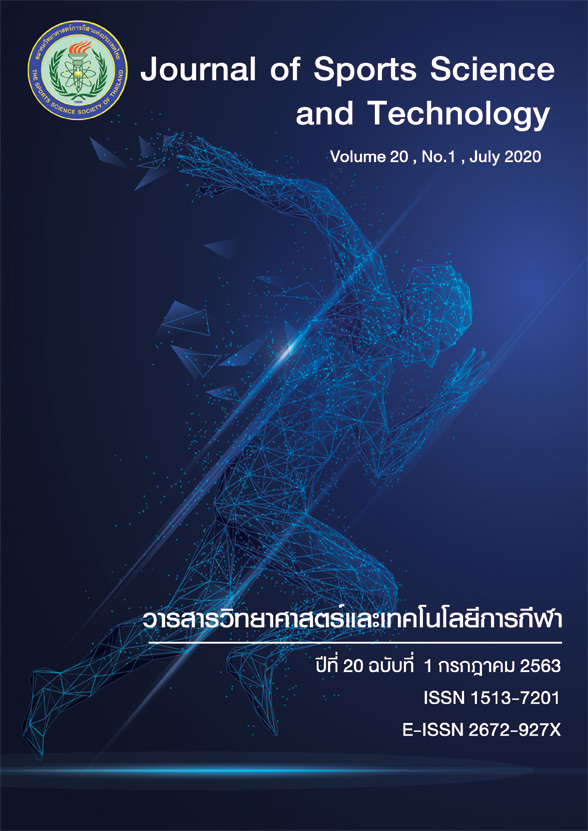THE ASSOCIATION BETWEEN MUSCLE LENGTH AND STRENGTH OF QUADRICEPS AND HAMSTRINGS MUSCLES IN PATIENTS WITH UNILATERAL KNEE PAIN
Keywords:
Clinical assessment, Anterior knee pain, Physical therapy, Muscle strength, Muscle lengthAbstract
Knee pain is a symptom commonly found in the clinic. Although several evidences support the effectiveness of Physical Therapy treatment, patients still have recurrent knee pain. This recurrence could be resulted from intervention focusing merely on muscle strength. Research evidences suggest restoration of balance between anterior and posterior muscle groups of the knee. However, those correlation findings came from lab-based studies, which would limit clinical application. Thus, the correlation between muscle length and muscle strength of these 2 muscle groups need to be clinically investigated. This study aims to determine the correlation among quadriceps and hamstrings muscle length (QFL and HTL, respectively), and their strength (QFS and HTS, respectively) in patients with unilateral knee pain. One-hundred and seventy-seven unilateral knee pain patient data from Physical Therapy Center, Mahidol University were reviewed. 60 patients were recruited. Chi-square test was used to determine the association. For ipsilateral side, result demonstrated significant associations between QFL and QFS (p=0.010), QFL and HTS (p=0.001), and between HTL and QFS (p=0.004), HTL and HTS (p=0.035). For contralateral side, finding showed significant associations between QFL and QFS (p<0.001), and QFL and HTS (p=0.002). There was no significant associations between HTL and QFS (p=0.110), and HTL and HTS (p=0.168). These results suggest that quadriceps and hamstrings muscle length could have an effect on their strength in patients with unilateral knee pain. The results from clinical assessment are consistent with lab-based assessment. In addition, the association between muscle length and muscle strength of quadriceps and hamstrings muscles should be taken into consideration for treating patients with unilateral knee pain.
(Journal of Sports Science and Technology 2020; 20(1): 62-70)
(Received: 22 February 2020, Revised: 25 February 2020, Accepted: 26 February 2020)
Key words: Clinical assessment/ Anterior knee pain/ Physical therapy/ Muscle strength/ Muscle length
*Corresponding author: Tippawan SITTI
Faculty of physical Therapy, Mahidol University, NaKhon Pathom, THAILAND 73170
E-mail: Tippawan.sit@mahidol.ac.th
References
1. Nimit-arnun N. Epidemiological situation and risk assessment of knee osteoarthritis among Thai people. Journal of The Royal Thai Army Nurses. 2014;15(3):185-94.
2. Lankhorst NE, Bierma-Zeinstra SM, van Middelkoop M. Risk factors for patellofemoral pain syndrome: a systematic review. J Orthop Sports Phys Ther. 2012;42(2):81-94.
3. Bizzini M, Childs JD, Piva SR, Delitto A. Systematic review of the quality of randomized controlled trials for patellofemoral pain syndrome. J Orthop Sports Phys Ther. 2003;33(1):4-20.
4. Wilson T. The measurement of patellar alignment in patellofemoral pain syndrome: are we confusing assumptions with evidence? J Orthop Sports Phys Ther. 2007;37(6):330-41.
5. Petersen W, Ellermann A, Gosele-Koppenburg A, Best R, Rembitzki IV, Bruggemann GP, et al. Patellofemoral pain syndrome. Knee Surg Sports Traumatol Arthrosc. 2014;22(10):2264-74.
6. Piva SR, Fitzgerald GK, Irrgang JJ, Fritz JM, Wisniewski S, McGinty GT, et al. Associates of physical function and pain in patients with patellofemoral pain syndrome. Archives of physical medicine and rehabilitation. 2009;90(2):285-95.
7. Hurley MV. The role of muscle weakness in the pathogenesis of osteoarthritis. Rheumatic diseases clinics of North America. 1999;25(2):283-98, vi.
8. Pappas E, Wong-Tom WM. Prospective Predictors of Patellofemoral Pain Syndrome: A Systematic Review With Meta-analysis. Sports health. 2012;4(2):115-20.
9. Patil S, Dixon J, White LC, Jones AP, Hui AC. An electromyographic exploratory study comparing the difference in the onset of hamstring and quadriceps contraction in patients with anterior knee pain. The Knee. 2011;18(5):329-32.
10. Patil S, White L, Jones A, Hui AC. Idiopathic anterior knee pain in the young. A prospective controlled trial. Acta orthopaedica Belgica. 2010;76(3):356-9.
11. Rice DA, McNair PJ, Lewis GN, Dalbeth N. Quadriceps arthrogenic muscle inhibition: the effects of experimental knee joint effusion on motor cortex excitability. Arthritis research & therapy. 2014;16(6):502-.
12. Rice DA, McNair PJ. Quadriceps arthrogenic muscle inhibition: neural mechanisms and treatment perspectives. Seminars in arthritis and rheumatism. 2010;40(3):250-66.
13. Palmieri RM, Ingersoll CD, Hoffman MA, Cordova ML, Porter DA, Edwards JE, et al. Arthrogenic muscle response to a simulated ankle joint effusion. Br J Sports Med. 2004;38(1):26-30.
14. Marks MC, Alexander J, Sutherland DH, Chambers HG. Clinical utility of the Duncan-Ely test for rectus femoris dysfunction during the swing phase of gait. Developmental medicine and child neurology. 2003;45(11):763-8.
15. Gajdosik RL, Rieck MA, Sullivan DK, Wightman SE. Comparison of four clinical tests for assessing hamstring muscle length. J Orthop Sports Phys Ther. 1993;18(5):614-8.
16. Reurink G, Goudswaard GJ, Oomen HG, Moen MH, Tol JL, Verhaar JA, et al. Reliability of the active and passive knee extension test in acute hamstring injuries. The American journal of sports medicine. 2013;41(8):1757-61.
17. Kendall FP, McCreary EK, Provance PG. Muscles testing and function with posture and pain. 5th ed. Baltimore: Lippincott Williams & Wilkins; 2005.
18. Bohannon RW. Measuring knee extensor muscle strength. American journal of physical medicine & rehabilitation. 2001;80(1):13-8.
19. Cuthbert SC, Goodheart GJ, Jr. On the reliability and validity of manual muscle testing: a literature review. Chiropractic & osteopathy. 2007;15:4.
20. Levy MN, Stanton BA, Koeppen BM. Skeletal muscle. Principle of physiology. 4th ed. Philadelphia: Elsevier Mosby; 2006. p. 175.
21. Berne RM, Levy MN, Koeppen BM, Stanton AS. Skeletal muscle physiology. Physiology. 5th ed. Missouri: Elsevier Mosby; 2004. p. 242-243.
22. Page P, Frank C, Lardner R. Assessment and treatment of muscle imbalance: the Janda approach. Champaign: Human Kinetics Publishers; 2010. p. 50-51.
23. Petersen W, Ellermann A, Gösele-Koppenburg A, Best R, Rembitzki IV, Brüggemann GP, Liebau C. Patellofemoral pain syndrome. Knee Surg Sports Traumatol Arthrosc. 2014 Oct 1;22(10):2264-74.
24. Waryasz GR, McDermott AY. Patellofemoral pain syndrome (PFPS): a systematic review of anatomy and potential risk factors. Dyn Med. 2008 Dec;7(1):9.
25. Harvie D, O’Leary T, Kumar S. A systematic review of randomized controlled trials on exercise parameters in the treatment of patellofemoral pain: what works?. J Multidiscip Healthc. 2011;4:383.






